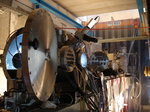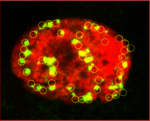Heavy Ion Microprobe
The Heavy Ion Microprobe at GSI can focus an ion beam from the UNILAC linear accelerator to a spot smaller than one micrometer in diameter. To achieve this, a 10µm section of the incoming beam is selected and guided via a magnetic quadrupole lens into a demagnified image in the target plane of the sample. The precise location of this ion optical image of the micro object aperture is defined by a beam-scanning magnetic dipole field. A low-noise electron detector with high gain will detect impacting ions by amplifying the electron cloud emitted from the sample for each incoming ion. A fast electrostatic beam switch will then block further incoming ions.
Spatially resolved radiation hardness testing in microelectronics
In some applications such as space/aerospace and particle accelerators, integrated electronic circuits are exposed to ionizing particle radiation that cannot be shielded due to high energy and long range. Since failures in these electronic devices can often have catastrophic consequences, radiation hardening and radiation hardness testing are essential steps in system development.
Using the Heavy Ion Microprobe allows us to add a new layer to traditional broad-beam radiation testing by pinpointing the exact locations of sensitive components within the tested devices. This precise information is fed back into the device design process, helping to reduce failure rates and improve reliability.
In addition to supporting the engineering of more radiation-hard devices, the microprobe also contributes to the broader understanding of the effects of ionizing particle radiation events in microelectronic circuits.
Similarly, detectors intended for use in particle accelerators and other radiation-prone environments can be tested using the microprobe, and subsequently optimized.
Radiation Biology
Densely ionizing particle radiation elicits grave consequences in biological systems. While ionizing radiation can be positively harnessed in medical treatments, such as radiation therapy, its effects are generally harmful and need to be strictly controlled in environments like human space flight or radiation exposure events like the Chernobyl accident.
To better understand these effects, it is necessary to investigate the effects of densely ionizing radiation on a cellular level as well as triggered biochemical reactions and repair processes. Using the microbeam, individual ions can be precisely directed to specific pre-defined locations within cell cultures. In collaboration with the GSI Biophysics Department, we conducted spatial and temporal measurements of biochemical reactions induced by individual ions.
GSI contact: K.-O.Voss(at)gsi.de; M.E.ToimilMolares(at)gsi.de







